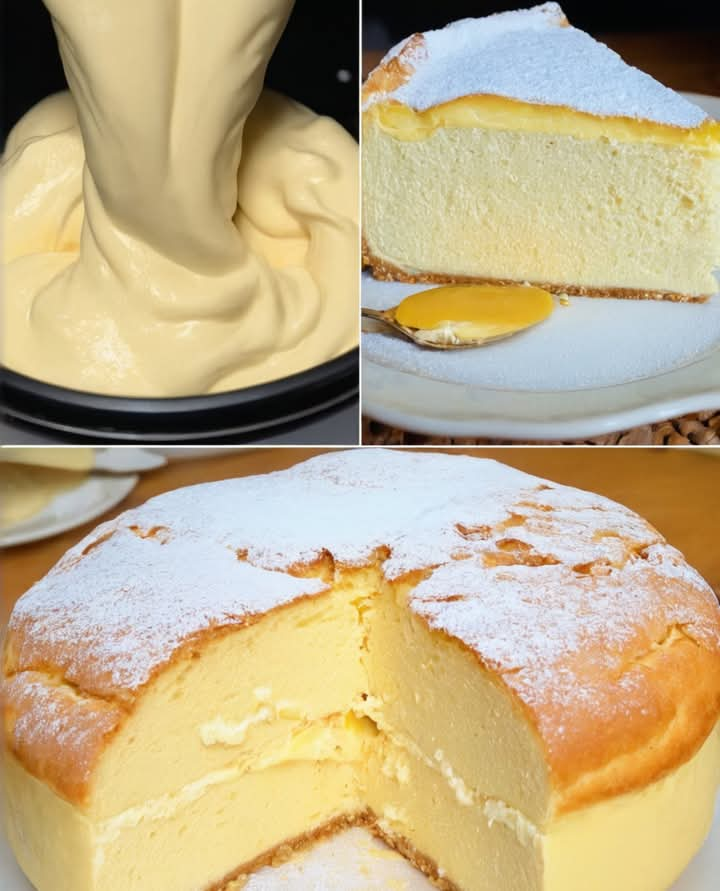Introduction
Japanese cheesecake stands apart from its Western counterparts with its ethereal lightness, delicate texture, and subtle sweetness. Often referred to as “cotton cheesecake” or “soufflé cheesecake,” this dessert achieves a perfect balance between the richness of cream cheese and the airy softness of a soufflé. Unlike dense New York-style cheesecakes, the Japanese version is jiggly, moist, and melts in your mouth, making it a favorite among dessert lovers worldwide.
The secret to its unique texture lies in the careful incorporation of whipped egg whites, which gives the cake its signature fluffiness. Combined with cream cheese, butter, and a touch of lemon zest for brightness, this dessert is both luxurious and light. While it may seem intimidating to bake at first, mastering this recipe is incredibly rewarding. The result is a cloud-like cake that is as beautiful to look at as it is delightful to eat.
Perfect for afternoon tea, special occasions, or simply as a treat to brighten your day, Japanese cheesecake is a testament to the elegance of minimalist baking. With patience and attention to detail, you can recreate this beloved dessert at home and experience a taste of Japan’s exquisite pastry tradition.
Recipe: Japanese Cheesecake
Ingredients
- 8 ounces (225g) cream cheese, softened
- 4 tablespoons (60g) unsalted butter, softened
- 6 large egg yolks
- ⅓ cup (65g) granulated sugar
- ½ cup (60g) all-purpose flour
- 1½ tablespoons (12g) cornstarch
- ¼ cup (60ml) heavy cream
- 1 tablespoon lemon zest, finely grated
For the Meringue:
- 6 large egg whites
- ⅓ cup (65g) granulated sugar
Instructions
Step 1: Prepare the Batter
- Preheat the oven to 320°F (160°C). Line the bottom of an 8-inch (20cm) round cake pan with parchment paper. Do not grease the sides, as the cake needs to cling to the pan to rise properly.
- In a heatproof bowl, combine the cream cheese and butter. Place the bowl over a pot of simmering water (double boiler) and stir until smooth and fully melted. Remove from heat and let cool slightly.
- Whisk in the egg yolks, one at a time, until fully incorporated.
- Add the sugar, flour, cornstarch, heavy cream, and lemon zest, mixing until the batter is smooth and free of lumps. Set aside.
Step 2: Whip the Meringue
- In a clean, dry bowl, beat the egg whites on medium speed until foamy. Gradually add the sugar while continuing to beat until stiff peaks form. The meringue should be glossy and hold its shape.
- Gently fold one-third of the meringue into the cream cheese mixture to lighten it. Then, carefully fold in the remaining meringue in two additions, being careful not to deflate the batter.
Step 3: Bake the Cheesecake
- Pour the batter into the prepared pan and smooth the top. Tap the pan lightly on the counter to remove any large air bubbles.
- Place the cake pan in a larger baking dish and fill the outer dish with hot water (about 1 inch deep) to create a water bath. This ensures gentle, even baking.
- Bake for 50-60 minutes, or until the top is golden and the center is set but still slightly jiggly.
- Turn off the oven and leave the cake inside with the door slightly ajar for 10 minutes to prevent sudden temperature changes, which can cause the cake to collapse.
Step 4: Cool and Serve
- Remove the cake from the oven and let it cool in the pan for 10 minutes.
- Run a thin knife around the edges to loosen, then invert onto a plate and peel off the parchment paper. Flip it back onto a serving plate to cool completely.
- For best results, refrigerate for at least 2 hours before serving. The texture becomes even more delicate and creamy when chilled.
Conclusion
Japanese cheesecake is more than just a dessert—it is a celebration of texture, balance, and precision in baking. Its cloud-like softness and subtle sweetness make it a unique indulgence that stands apart from heavier cheesecake varieties. While the process requires patience and attention to detail, the reward is a flawless, melt-in-your-mouth experience that is well worth the effort.
What makes this cheesecake truly special is its versatility. It can be enjoyed plain, dusted with powdered sugar, or accompanied by fresh berries and whipped cream. Its delicate nature also makes it an excellent canvas for flavor variations, such as matcha, chocolate, or citrus infusions.
For those seeking to expand their baking repertoire, mastering Japanese cheesecake is a fulfilling challenge. The technique of folding meringue into the batter and baking it in a water bath may seem daunting at first, but with practice, it becomes an achievable and deeply satisfying skill.
Ultimately, this dessert embodies the Japanese philosophy of simplicity and perfection—where every ingredient and step serves a purpose in creating something extraordinary. Whether shared with friends or savored as a personal treat, Japanese cheesecake is a testament to the beauty of delicate, thoughtful baking.
